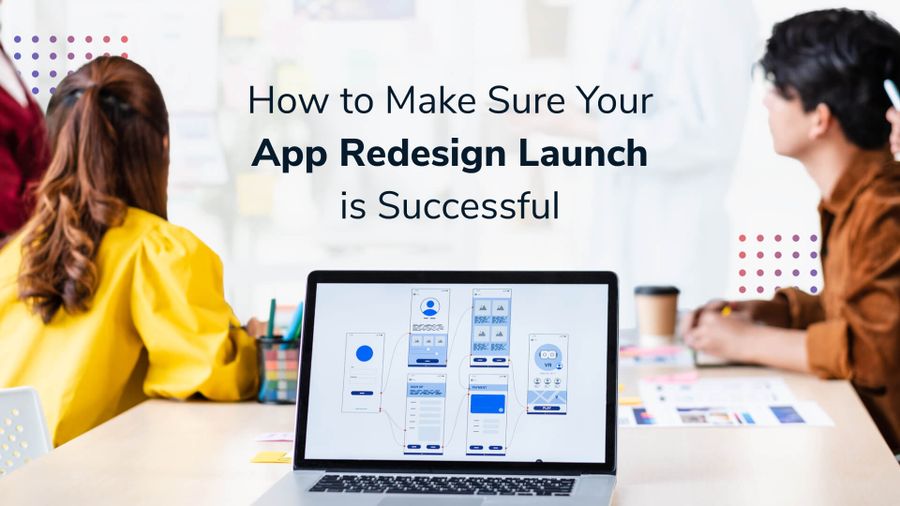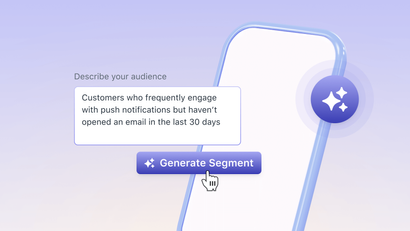With the rapid evolution of modern app UI and ever-rising user expectations, it’s important for you to ask yourself when an app redesign is appropriate for your company.
Designers continually work to reduce friction, enable feature adoption, and increase engagement with your platform and all it has to offer, which is no small task. Although an app refresh might not sound like a big deal to someone outside this field, it’s no easy process and there are a lot of factors that play into whether it’s worth the time and resources your company will put towards these changes.
In making sure your app redesign launch is successful, you’ll first need to unpack whether redesign is the best option for your business at this time.
Assess Whether a Redesign is the Best Option
Before setting your sights on app redesign, you should evaluate whether now is the time and place to embark on this process.
So what are the signs you need to redesign your app?
Outdated App Interface
Maybe your company has recently rebranded with a logo and color redesign. Maybe your app no longer fulfills user’s design expectations, because of how quickly user experience trends evolve over time.
Performance Issues
Perhaps your app is experiencing issues such as stability, responsiveness, and speed.
App users are notoriously impatient and judgmental, and won’t hesitate to abandon your app should its performance fall short of what they expect or inconvenience them.
In one study, 80 percent of mobile users indicated they would only attempt to use a problematic app three times or less.
Changes To Your Product and/or Users’ Needs
Another reason it might be time for an app refresh is to adapt to changing needs. Maybe your userbase is growing, or your product line is evolving, either of which might require changes to the UX.
Step 1: Clearly Define Your Goals
Based on the core improvements your team has identified in your initial conversations, you’ll want to clearly map the goals of your app redesign. What is the overarching objective of your app refresh and how can you ensure that your team is on board with this goal throughout the entire process?
Your broader goal could relate to your app’s functionality or features, the UI improvements you hope to make, alterations you’re making in response to broader industry changes, or updates you’re making to differentiate yourself from your competition..
Beneath your broader objective, get granular in defining what elements of your app will need to change, whether it’s improving your onboarding, design systems, or accessibility. Perhaps you’re aiming for a cleaner UI or to implement a more responsive design.
Give Yourself a Reasonable Timeline
Within your roadmap, estimate how long each phase of your redesign should take based on the bandwidth of the teams working on the refresh. Allocate time for proper testing and troubleshooting.
Look at Drop Off and Conversion Rates
Where are users dropping off in their app usage? Are there trends you can point to in terms of where you’re losing users through their in-app journey? Figuring out where and when users lose interest or fail to take an action can clue you in on what you need to improve within the app experience. These falloff points can point directly inform to areas you should improve within your refresh, and how you can better retain your users over the long run.
In addition to understanding problematic areas of the app experience, figure out what moments are working to convert and excite your users.
To do so, look into user behavior across your analytics stack. Dig into your existing tools, such as your Google Analytics, Mixpanel, and more, to understand your users’ behavior across your platform, including what actions they are and aren’t taking. Study important touchpoints within the app journey as well as your app’s core KPIs.
Check User Reviews of the App
App reviews are not only most users’ desired space for communicating what they don’t like about your product, but they are also an important reference that potential users look to before deciding to download your platform.
Combing your reviews, both the positive and the negative, for constructive criticism, can help you identify areas of the product that need work.
Improving your reviews can also influence whether or not users download your app in the first place, which translates to the healthy growth of your user base down the line.
Research showcases the value of even subtle changes in app reviews. One study finds that star ratings and user reviews are 34 percent of consumers’ top consideration before they download an app.
Step 2: Elicit Feedback From Active Users
Collecting user feedback empowers you to more directly address pain points, drive feature improvements, and in enhance the in-app experience.
You may have identified trends in where users are dropping off, but it’s important to validate your assumptions around the root cause of app abandonment in order to properly drive the appropriate changes. Some ways you can elicit feedback from your existing userbase include the following..
Email Feedback
A tried and true mechanism of collecting user feedback is through the email channel. Distribute your surveys through email to connect with your customers about the improvements they hope to see within your platform.
In-App Surveys
An In-App Survey is an abbreviated version of a traditional survey that’s embedded directly in the app experience. These simplified feedback forms provide a direct and targeted line of communication with your customers and allow you to seamlessly collect the data you’ll need to optimize your product—all while your users are active on your platform.
Step 3: Evaluate Responses
After you’ve collected your users’ valuable feedback, you should aggregate analyze and your data to drive the next phase of your refresh plan.
Depending on the types of data you’re collecting from users, whether it’s qualitative or quantitative in nature, your evaluation process may be different.
Here are some standard types of responses you might be collecting.
Customer Satisfaction: Unsure what your users think about you or your product? Implement a quick 1 through 5 point rating scale to measure customer sentiment.
Polls and Pulse Checks: Looking to understand whether a your in-app content was useful or to collect input on a specific topic? Gather direct input at the point of interaction without directing them away from your app.
Feature Requests / Prioritization: Prioritizing what to work on? Hear from your users about which features are most important to them.
Step 4: Take a Look at Your Competitors
What are your competitors doing in their platform that you may be falling short of?
Are their features more robust or easier to use than yours? How is their UI organized? It never hurts to scope out what your competition is doing and how they might be better positioning their core offering. Based on what you find in your competitor audit, you can decide what elements you should work on in your app redesign.
First, define your top competitors, both direct and indirect.
Direct competitors offer the same value prop to the same audience, whereas indirect Competitors either offer a similar value prop to a different audience segment or a different value prop to the same audience segment you cater to.
Some areas you might focus on in your competitive analysis can include the following..
- Product strengths
- Product weaknesses
- Standout features
- Ratings and user feedback (both positive and negative)
Step 5: Perform an Audit of the UX
Performing a comprehensive audit of your existing UX is a wise idea before you pour company resources into an app redesign.
As part of your audit, you may evaluate your app’s foundational design system styles, your platform’s current components and layout, as well as your app flows.
Design Components and Layout: Consider your fonts, brand colors, icons, and illustrations as part of your audit.
Design System Styles: Design systems are frameworks for creating mobile experiences. In considering which design system is best for your mobile app, think about aligning your UI and your UX,
Mobile App Flows: A mobile app flow is the path a user takes to navigate from one screen to another, or to navigate between features on your mobile app. Evaluate your flows for friction in your audit.
Step 6: Consider New Visual Components
After looking at your existing UX, you may decide to implement new visual components.
Maybe you want to introduce novel UI patterns, brand colors, animations, AR or VR, or motion design!
UI Patterns: Your UI patterns include your splash screen (or the first screen users see when they open your app), onboarding screen(s), home screen, checkout screens, and more.
Brand Colors: Your brand colors are a fundamental element of your brand’s design playbook. Popular colors trending in mobile app design will change over time, so you might modify your mobile experience based on what’s working in the space.
AR, VR, and Motion Design: You can consider using these three cutting-edge design trends as you revamp your mobile app.
Step 7: Launch New Iteration
Launching your refresh will be a different process depending on the steps you’ve decided on in your initial roadmap. Some product design teams may decide to test their refresh in parallel with the existing version of the app. Others will roll out the refresh to small test groups before a final release. A/B and user testing are always advisable in this stage.
Step 8: Introduce Users to Changes & Updates
When users are first introduced to your update, you’ll want to get them acquainted with the exciting changes you’ve made. This is where using a variety of user messaging channels can be helpful.
Before you release your new iteration, you need to build out the communication campaigns you will leverage to educate and excite users about the new refresh.
Email sequences and in-app messages are both ideal options for re-educating your users on your new updates.
Carousel In-App Messages
Using carousel In-App Messages, or IAMs, you can set up a flow to walk users through your product or service. Each IAM card delivers a bite-sized training point, breaking things down step by step to get users up and running as quickly as possible.
After you’ve familiarized users with your new app, you can pivot your IAMs to discovery. Our client Radio Free Europe (RFE), for instance, is a broadcaster with broad mobile app functionality. They used IAMs to cross-promote features, functionality, and content, which led user retention to jump by 15 percent.
Getting Started with OneSignal
OneSignal is designed to help you send notifications and seamlessly manage your user communication across a variety of channels, including mobile push notifications, web push notifications, bulk SMS, in-app messaging, and email. Our platform is quick to set up and makes it easy to send eye-catching messages without doing any development work. If you don't have a OneSignal account, you can create one for free and start sending push notifications to your users today. Don't take our word for it — simply sign up and see for yourself!
Create a Free Account



